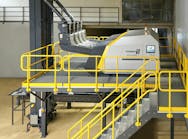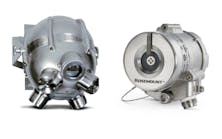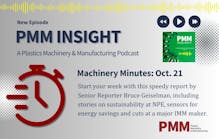Two-stage process The typical process of reusing post-consumer and post-industrial resin (PCR and PIR) includes steps for grinding, melting, filtering, degassing and pelletizing. Pellets are then introduced to an injection molding machine (IMM) to be again melted, then molded. At the K show, Engel planned to display a production cell with its new two-stage process using a legacy Engel duo 12060H/80Z/900 IMM with a modified injection unit to produce rolling dolly pallets from PIR. The machine separates the plasticizing and injection steps, with a screw dedicated to each of these steps. Flakes are fed into a first plasticizing screw, then the melt enters a melt filter and degassing unit before crossing through a transfer head to the injection screw. The modification of the IMM is not available as a retrofit.
What’s new? The degassing unit, which is incorporated in the IMM. Engel’s developers focused on this unit because a melt filter alone is not enough to completely remove residual moisture and volatile substances, which can cause surface defects and impair mechanical load bearing capacity of finished parts.
Benefits Lower energy use and a decreased carbon footprint. Engel calculates that, by eliminating an intermediate pelletizing step, the two-stage process cuts energy requirements by 30 percent. The two-stage process also decreases carbon dioxide emission.
Engel Machinery Inc., York, Pa., 717-764-6818, www.engelglobal.com
David Tillett | Associate Editor
Associate Editor David Tillett writes and edits for Plastics Machinery & Manufacturing, Plastics Recycling and The Journal of Blow Molding. He covers new products, industry news, patents and consumer and business equipment. He has more than 20 years of experience in daily newspaper, online and magazine journalism.






